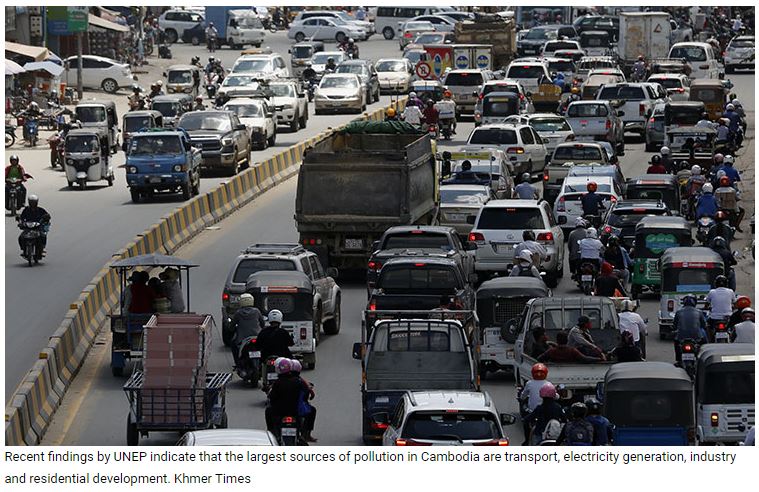Cambodia: Transport main contributor to air pollution, says study
Transport is one of the main contributors to air pollution in Cambodia, according to the Clean Air Plan, which was launched in the country early this year.
To combat the threat of air pollution, the United Nations Environment Programme (UNEP), through the Asia Pacific Clean Air Partnership and the Climate and Clean Air Coalition, partnered with the Ministry of Environment to develop the country’s first Clean Air Plan in January 2022.
The Ministry of Public Works and Transport said the number of registered vehicles in the Kingdom increased by around 65 per cent from 2015 to 2019.
Similarly, UNEP’s Global Trade in Used Vehicles Report found that Cambodia is one of the countries in the region with substantial imports of used vehicles. The report pointed out that these are usually over ten years old and significantly contribute to air pollution and climate emissions.
“Air pollution could not only be considered as a local problem but a regional and global phenomenon which requires contribution from all parties,” Say Samal, Minister of Environment, was quoted as saying in a UNEP release. “This plan is a significant step towards identifying science-based policy decisions towards managing air quality in the country.”
According to the UNEP report, air pollution has come from wood and charcoal burning, agricultural fires and the incineration of waste. Cambodia has now been facing a wave of urban pollution. Recent research by UNEP indicated that the largest sources of pollution in Cambodia today are transport, electricity generation, industry and residential development.
However, Cambodia is not the only country facing the threat of air pollution. Approximately 99 per cent of the global population breathes unclean air, and air pollution is responsible for seven million deaths annually, or more than 10 per cent of all fatalities.
Cambodia’s Clean Air Plan, based on the UNEP report Actions on Air Quality, outlines a package of measures to address the major sources of current and future emissions in the country.
The plan, which will measure health-damaging air pollutants, will also collect data from the transport, agriculture, construction, energy and water sectors.
According to UNEP, once fully implemented, the plan could reduce two major pollutants, PM 2.5 and black carbon, by 60 per cent. It could also help slash emissions of methane and carbon dioxide, key drivers of climate change, by 24 per cent and 18 per cent, respectively, by 2030. Those improvements would help Cambodia avoid almost 900 premature deaths per year, the report noted.
One of the goals of the Clean Air Plan is to raise standards for vehicle emissions. It also aims to limit the age of imported cars, transitioning the country’s automotive fleet to newer, less polluting vehicles that meet stringent European Union standards.
The plan also found that construction was a major contributor to pollution and that by managing the release of dust and particle matter into the environment, pollution could be significantly reduced.
Some of the plan’s other measures include improving cookstoves and shifting from biomass to biogas for cooking. The plan builds on 25 clean air measures developed by the Asia Clean Air Partnership.
“The launch of the Clean Air Plan is an important step and underlines Cambodia’s commitment to improving air quality,” said Dechen Tsering, UNEP Regional Director and Representative for Asia and the Pacific. “We look forward to continuing working with the Ministry of Environment to support these efforts,” Tsering added.
Source: https://www.khmertimeskh.com/501138415/transport-main-contributor-to-air-pollution-says-study/


 Thailand
Thailand




